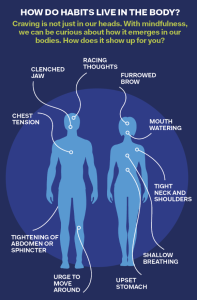I have said it before and here it is again: I will continue cleaning up my habits every day until they are all great. I am still working on eating. While working on this topic, I found an infographic about how mindfulness helps break the chain of bad habits. It’s really cool but too long to put into this LIFEies. Go here to read it all — it’s worth your time.
My focus today is where habits live in your body. Both good and bad habits can activate a physical response. Below is a part of the whole infographic that covers this idea. For me, I noticed my stomach gives me false hunger pains, my mouth waters at any mention of food I love, and my mind races to all the ways I can get food. Crazy. My eating habit is everywhere in my body… only my big toe is immune so far.
Where do your bad habits live in your body? How can you use these signals to start changing your behavior and habits to make them good? Here are a few suggestions I am trying:
1. From the Stoics—Pause before you do anything. You are in charge.
2. From Untethered Soul, ask yourself, “What part of me is hungry?”
3. From Mindfulness, try breathing techniques like this.
It is a process. The process is now.

Rule #10 from my book The Fantastic Life: Take the Decision Out of the Moment
When your body pushes you towards a bad habit, you can either give in or resist. Set yourself up for success and put practices into place that help you turn your physical signals towards more productive habits.
How Mindfulness Works to Break Bad Habits
Habits are formed and strengthened as we journey through a continuous loop seeking to satisfy our urges. Here’s how to break the cycle.
By Judson Brewer
![]()
January 10, 2019
If there’s a patch of open lawn at a corner, children will cut through, and grass soon becomes hardened ground. Ancient people created paths walking from one place to another; horses and oxen widened them; and today they’re paved roads. When we want to go someplace, we choicelessly take these well-trodden paths.
It’s the same with our brain and the muscles and organs that respond to its commands. As neurons keep firing in a particular configuration, a path is created and it’s just easier to go there. Neurons that “fire together, wire together.” It’s how we learn to talk, to play guitar, to paint, and to smoke and overeat.
As Judson Brewer points out in The Craving Mind, laying down memories (pathways to return to) is as ancient and ingrained as life itself. Eric Kandel won the Nobel Prize in Physiology in 2000 for demonstrating that even the lowly sea slug—hardly a big-brained cousin to humans—employs a “two-option approach” to raise its chances of survival: “move toward nutrient, move away from toxin.” Likewise, we adapted by laying down memories of what is and isn’t food and where to find it, so we could return for more. And, critically, the food offered us a reward: a shot of brain chemicals that signal satisfied hunger. Yum. Yum.
This reward-based learning system, Brewer notes, is easily hijacked to develop other habits: See cool kids smoke. Smoke to be cool. Be seen as cool. Feel good. Lay down a feel-good memory. Want to do it again.
Once laid down, this path takes us round trip; we’re on a loop. Seeing people smoke triggers us, and the immediate effect is the brain saying “that will make me feel better or lessen the pain.” An urge, a craving, emerges in the body. We take action to feed the craving and light up. We get the good feeling (our reward), but we also start to see the world differently. In what psychologists call increased “salience,” we now wear smoke-colored glasses that offer a landscape filled with perceived opportunities to smoke. The habit is reinforced, and the increased salience points us to more cues and triggers that keep the wheel spinning. Round and round we go.
Mindfulness can break this well-worn cycle, as we see illustrated in the diagram conceived of by Brewer below.

Click here to view the entire chart.
